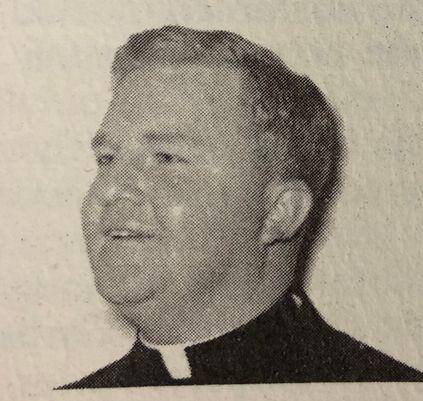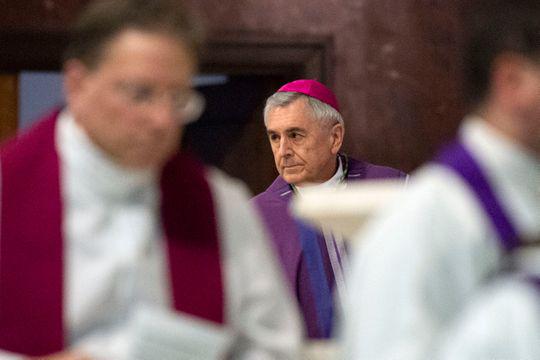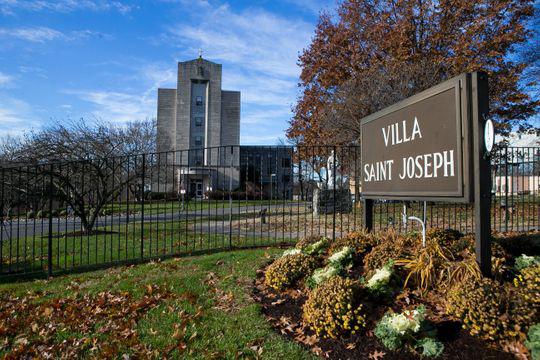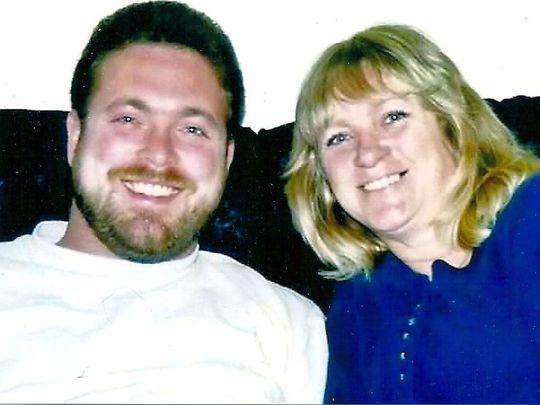|
‘It happened everywhere': How Pa. upended deep history of priest abuse across the nation
By Mike Argento
[with video] The grand jury implored everyone to take heed of all they had learned. Here's how their report shook up the world. Marcia Hince lived with it all her life. It’s difficult to explain. It was like a malignant growth, something that resided inside her being, infecting her soul, hoping against hope that ignoring it or suppressing her thoughts about it would make it disappear. She felt alone, isolated, cut off from the rest of humanity, as if she were an alien being occupying a human body. “I felt like I was the only person this happened to,” she said, “that I was outside the human race.” She remained silent about it for years. Then, in 2002, after the Boston Globe’s groundbreaking expose of child sexual abuse perpetrated by members of the Catholic clergy, she reported what happened to her to the Harrisburg diocese, writing a letter that outlined the abuse she endured and the consequences on her life. “I would like the church to recognize and understand, plainly and simply, that I was badly hurt,” she wrote. “It would be nice to know the church is sincerely caring and sorry about that. The evidence in the news so far is not convincing.” Among the remedies she sought was the return of a portrait of her, taken when she was a teenager, that a family friend had told her still hung on the priest’s wall. The church never publicly acknowledged her abuse. Then, in August, the epic report from the Pennsylvania grand jury investigating clergy sexual abuse came out. On page 528, the report listed the offenses committed by the Rev. James Beeman. It gave her some sense of justice that the priest was held to account for his sins. Her story was recounted in the description of his crimes. She was abused between 1956 and 1960. The report described another of Beeman’s crimes. In 1961, he had raped a 7-year-old girl who was in the hospital having her tonsils removed, the first of several sexual assaults that continued for 12 years. Hince, now living in California, knew that she was not alone, that her misery had plenty of company. Broad scope of Pa. grand jury reportThe investigation by the 40th Statewide Investigating Grand Jury wasn’t the first into the epidemic of child sexual abuse among Catholic priests. It wasn’t even the first to be done in Pennsylvania, following investigations of the Philadelphia archdiocese and the Altoona-Johnstown diocese. But its scope was unprecedented. “We, the members of this grand jury, need you to hear this,” the nearly 900-page report begins. “We know some of you have heard some of it before. There have been other reports about child sex abuse within the Catholic Church. But never on this scale. For many of us, those earlier stories happened someplace else, someplace away. Now we know the truth: it happened everywhere.” The report covered six dioceses in Pennsylvania, accounting for 54 of the state’s 67 counties. For five years, the grand jury heard testimony from dozens of witnesses. It reviewed half-a-million pages of diocesan internal documents, subpoenaed from the church’s secret archives that cataloged decades of horrendous abuse and the church’s efforts to cover it up. The grand jury identified 301 predator priests who preyed on more than 1,000 victims. Hince was among them, alone no longer. How a predator groomed his victimHince was born in Charlotte, N.C., her family moving to Lancaster when she was a child; her mother’s family was from Lancaster. Her parents owned a doughnut shop and the entire family – she and her four siblings – worked selling doughnuts door-to-door. They settled in St. Mary's parish in the city, a diverse parish that served some of the more impoverished members of the congregation. And that’s where she met Beeman. She met the priest when she was seven, around 1955, through a friend who had taken her to a youth group that the priest ran out of a storefront in the neighborhood called the Blessed Martin de Porres Society, named for the Peruvian lay brother beatified in 1837, the patron saint of mixed-race people and those seeking racial harmony, among others. The priest was viewed as “a good guy,” Hince recalled, expanding the church’s reach into the African-American community and seeking to bring diverse people together, an enlightened posture in the segregated ‘50s. “The whole parish loved him,” Hince said. “He really thought of himself as a good guy, a good priest.” The day she met him, she recalled, he paid attention to her, talking to her, asking about her family. She recalled he was sitting in a chair and she stood next to him, feeling the aura that emanated from this holy man. “I was a sweet 7-year-old who was indoctrinated in the church, and here was this priest being nice to me and expressing interest in me,” she said. The interest continued past that day. Beeman took an interest in her family, doing nice things for them. Her family never had much money, and Beeman would take her and her older sister out to dinner. It was special, she said. Her family couldn’t afford to go out to dinner. He took them to the movies and miniature golfing and bowling, the kinds of things kids did back then. When she was 8 or 9, he took her to the International Horse Show at the Harrisburg Farm Show complex. Like many young girls, she loved horses. He would later take her horseback riding. When her family was having money issues, she recalled, he would slip her mother a 20, a lot of money in the '50s. In short, he did a lot to ingratiate himself, to make himself a part of the family and a part of her life. He was a constant presence at her home, something that made her devout mother feel special that this holy man was taking an interest in her family. He gave Hince gifts, starting with small things, clothing and whatnot and moving up to a Hamilton watch. He once took her out of school to go to the Van Sciver furniture store to buy her a bedroom suite. He bought her a used piano and paid for lessons, something that didn’t last, as she was not very motivated to learn to play. “Slowly it started turning into something else,” she said. When she was 8, she recalled, they went to an exhibit at F&M College. Beeman held her hand, entwined his arm around hers and held her closely. He began molesting her at about that time. The abuse continued until she was 11 or 12, when Beeman was transferred to a parish in Carlisle. He returned to visit often, though, and stayed in touch with her, writing her what can only be described as love letters. “They were disgusting,” she recalled. When she turned 13, she gathered the courage to tell him to stop writing to her. Yet, he remained obsessed with her. When she was 14, he paid to have a professional portrait taken of her, the photo that, along with other photos of her as a child, hung on his wall for years. He came to visit her when she was 15. She didn’t want him to be there, but her mother told her, “But, Marcia, he loves you.” His pursuit of her continued after she graduated from high school and went to college in Pittsburgh. He asked to visit her, and she told him no. His behavior transcended abuse, escalating to psychological torture. “I don’t understand,” she said. “I don’t understand. I don’t understand.” Long history of pedophile priestsTo understand the clerical sexual abuse in the Catholic church, it helps to understand its lengthy history. In a paper published in the Journal of Child Sexual Abuse in July, two professors at the University of Massachusetts, Faisal Rashid and Ian Barron, traced the history of child sexual abuse among Catholic clergy to the church’s earliest days in the first millennium. “Debates in international forums and in mainstream media on the role, responsibility, liability, and response of ecclesiastical authorities of the Roman Catholic Church toward clerical child sexual abuse fail to take into account the historical roots and awareness of the problem,” they wrote in the paper, titled “The Roman Catholic Church: A Centuries Old History of Awareness of Clerical Child Sexual Abuse (from the First to the 19th Century).” The authors of the report wrote that despite publicly condemning the centuries-old history of clerical abuse, the church, between the 14th and 20th centuries “developed a culture of secrecy” codified in the sect’s “clandestine organizational management models and institutional laws...aimed to manage clerical child sexual assault.” It took literally centuries for secular authorities to break that secrecy and bring the scope of the abuse to light. How Pa. grand jury investigation beganThe Pennsylvania investigation began when two cases were referred to the state Attorney General’s office in August 2012 and January 2013. Those cases, involving a now-defrocked priest named George Koharchik and Franciscan Brother Stephen Baker, led to the grand jury investigation into the Altoona-Johnstown diocese. That grand jury passed on information about 16 other instances of abuse to the Attorney General’s office. In 2013, the initial cases landed on the desk of prosecutor Daniel Dye, a career prosecutor who, before joining the AG’s staff, had prosecuted sex crimes in the Lancaster County District Attorney’s Office. The investigation soon widened in scope. Dye told the Philadelphia Inquirer, “The more people I met and the more living rooms I sat in all across the commonwealth, this concept started coming to mind of like an oppressed people – an entire population who were silenced and oppressed and could not be heard. It was a profound thing to experience.” That came across to survivors, that the man in charge of the investigation wasn’t simply going through the motions, that he really cared about correcting decades of injustice. “I think the world of Dan Dye,” said Juliann Bortz, a survivor who lives in the Allentown area. “He wants to correct the wrongs, but there’s more there. He told all of us that we’re going to make this right. Dan Dye is an incredible young man.” Bortz, now 68, was sexually abused by a priest when she was a freshman at Allentown Central Catholic High School, her case described in the grand jury report. The report also outlined how the church tried to discredit her, investigating her background and her family, when she sued the church. It was a revelation to Bortz. “It was a shock,” she said. “It’s crazy, absolutely crazy.” She has since filed a lawsuit against the church, claiming that its efforts to discredit her constituted defamation. The suit is pending and the church has denied her claims that it actively investigated her. The grand jury investigation, meanwhile, is ongoing and there are more wrongs to right. As such, Dye’s work continues, even as the repercussions of the grand jury report continue to unfold. The state Legislature is still grappling with reforming the laws governing the statute of limitations on civil suits, an effort advocates say is necessary because the church’s decades-long cover-up of abuse ran out the clock for survivors to get some justice. ‘He stole my soul’The repercussions of the abuse have always been there for survivors. Hince lived in denial about the effects of the abuse for years, pushing those terrible memories away, burying them in some dark corner of her psyche. After graduating from college, with a degree in psychology, she moved to San Francisco and began working as a social worker. When she was about 30, she was called for jury duty and had just about made it through the day without being selected to hear a case. Then the last case of the day was called, and she was among the prospective jurors ushered into the courtroom. The case involved a man accused of molesting a 6-year-old girl. She panicked. She didn’t know what she was going to do if her name was called. Eleven jurors were selected without her name coming up. There was one last juror to be picked and she just knew it was going to be her. It was. The judge asked her whether there was any reason why she couldn’t serve as a fair and impartial juror, and she replied, “I was involved in something similar as a child.” The judge excused her without probing further. “I went outside and freaked out,” she said. “That’s when I realized it hadn’t gone away. He stole my soul, is what he did. He stole my soul.” Other states follow Pa. grand jury exampleSince the grand jury report was released in August, 13 other states and the District of Columbia have launched investigations into clerical sexual abuse in the Catholic church, according to a survey of all 50 states conducted by NBC News. Those states include New York, New Jersey, Missouri, Nebraska, Maryland, Florida, Michigan, among others. In Illinois, Attorney General Lisa Madigan opened an investigation based on the findings of the Pennsylvania grand jury that at least seven priests with connections to Illinois were named in its report. “The Catholic Church has a moral obligation to provide its parishioners and the public a complete and accurate accounting of all sexually inappropriate behavior,” she said in a statement. The church continues its efforts to stay ahead of the investigations. In early December, two Jesuit provinces released the names of more than 150 clergy credibly accused of sexual abuse claims dating to the 1950s. Additionally, the U.S. Department of Justice has opened a federal investigation into the church, seeking to determine whether any cover-up by church officials was in violation of federal Racketeer Influenced and Corrupt Organizations Act, the so-called RICO statute, used, more often than not, to combat organized crime syndicates. The investigation, described as groundbreaking, is the first effort by the Justice Department to investigate the church, according to reports. Survivors of abuse have reported speaking to FBI agents and are hopeful that the investigation bears fruit. “The FBI told me they can only look back five years,” Bortz said. “I hope they find something.” Confronting her abuser, and the churchIn 1980, Hince traveled back to Pennsylvania to confront Beeman. She went to his home and spoke to him about what he did and how it affected her. It was then she saw her photos on his wall. She told him to take them down. In 1989, she reported her abuse to the Lancaster police. The police informed her that they couldn’t do anything because the criminal statute of limitations had passed. There have been several attempts to lengthen the statute of limitations – the latest push coming this fall – but none have been successful. In 2001, a family friend visited the priest and told her that he still had her photos on the wall. The following year, after the Boston Globe’s reporting was published, she wrote to the diocese to report her abuse. She hadn’t considered reporting it to the church, believing that doing so would be pointless. “This was me standing up to the freaking church,” she said. “It was me speaking. This time, I got to say what I want. I got to stand up for myself.” She followed up, meeting with diocese officials and telling them how the abuse had affected her life, that she lived for years blaming herself for what happened to the detriment of just about every aspect of her life. She told the church she had spent somewhere in the neighborhood of $18,000 on therapy over the years. She said the church official she was speaking to left the room and returned with a check for $18,000. “I should have told him it was more,” Hince said. And she asked that her photos be returned. They were. Beeman died in 2016. The public revelations, coming as they did after his death, still provided Hince a measure of justice, that what happened to her has been acknowledged and that she was not so all alone. “First ‘Spotlight’ and now this (the grand jury report),” said Hince, now 70. “It’s all public. It still blows my mind that it’s all coming out.”
|
.
Any original material on these pages is copyright © BishopAccountability.org 2004. Reproduce freely with attribution.




